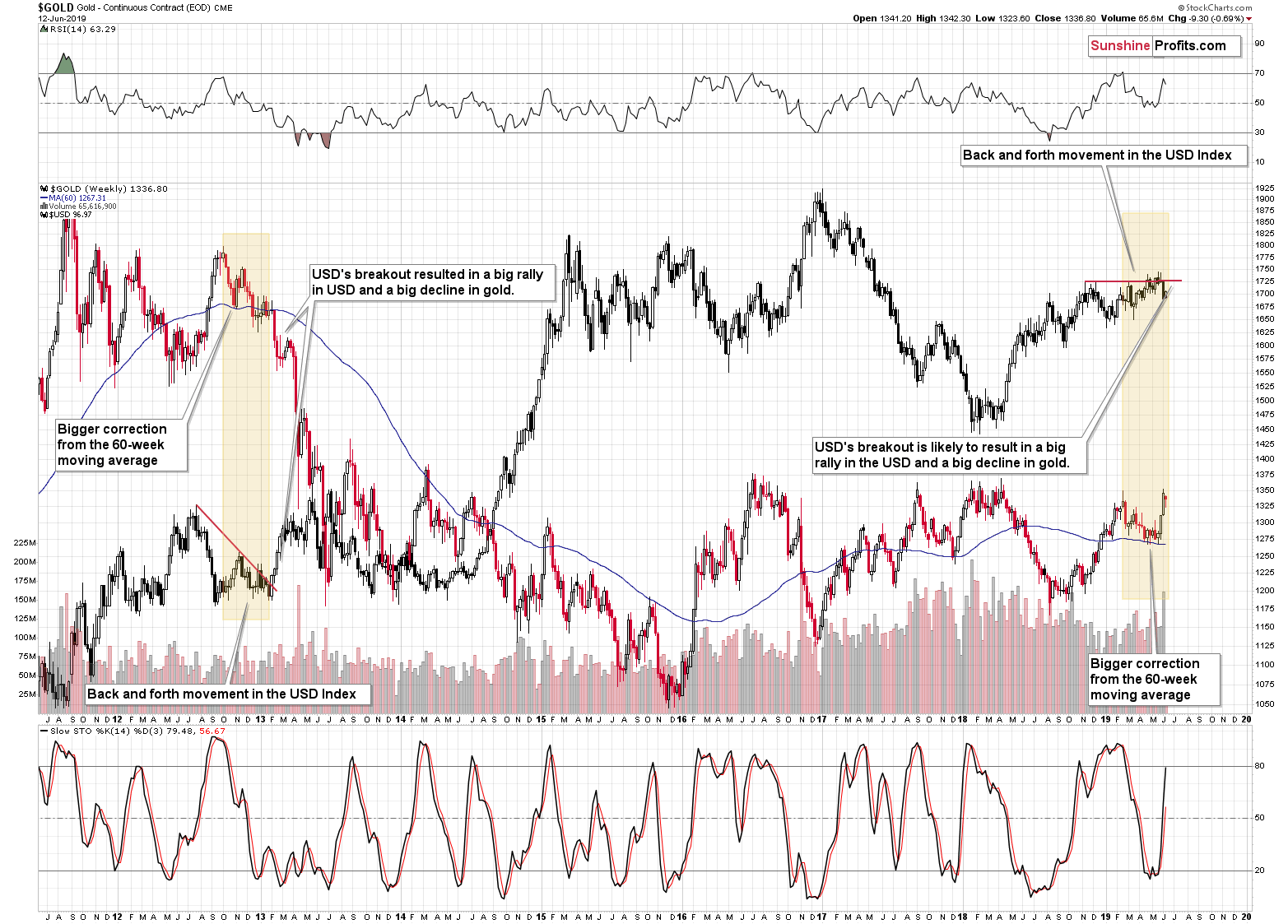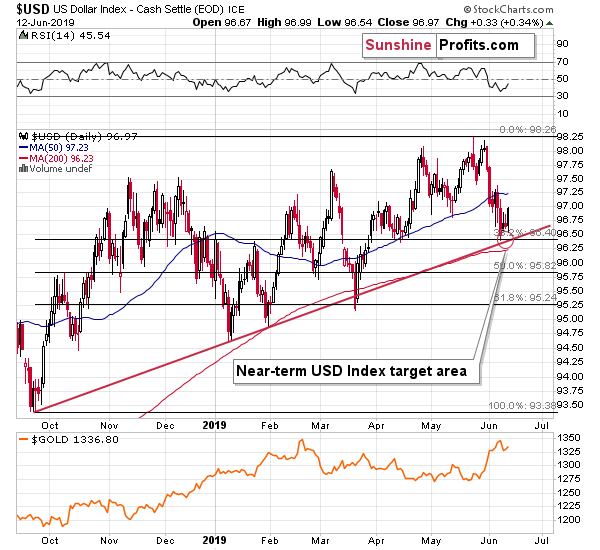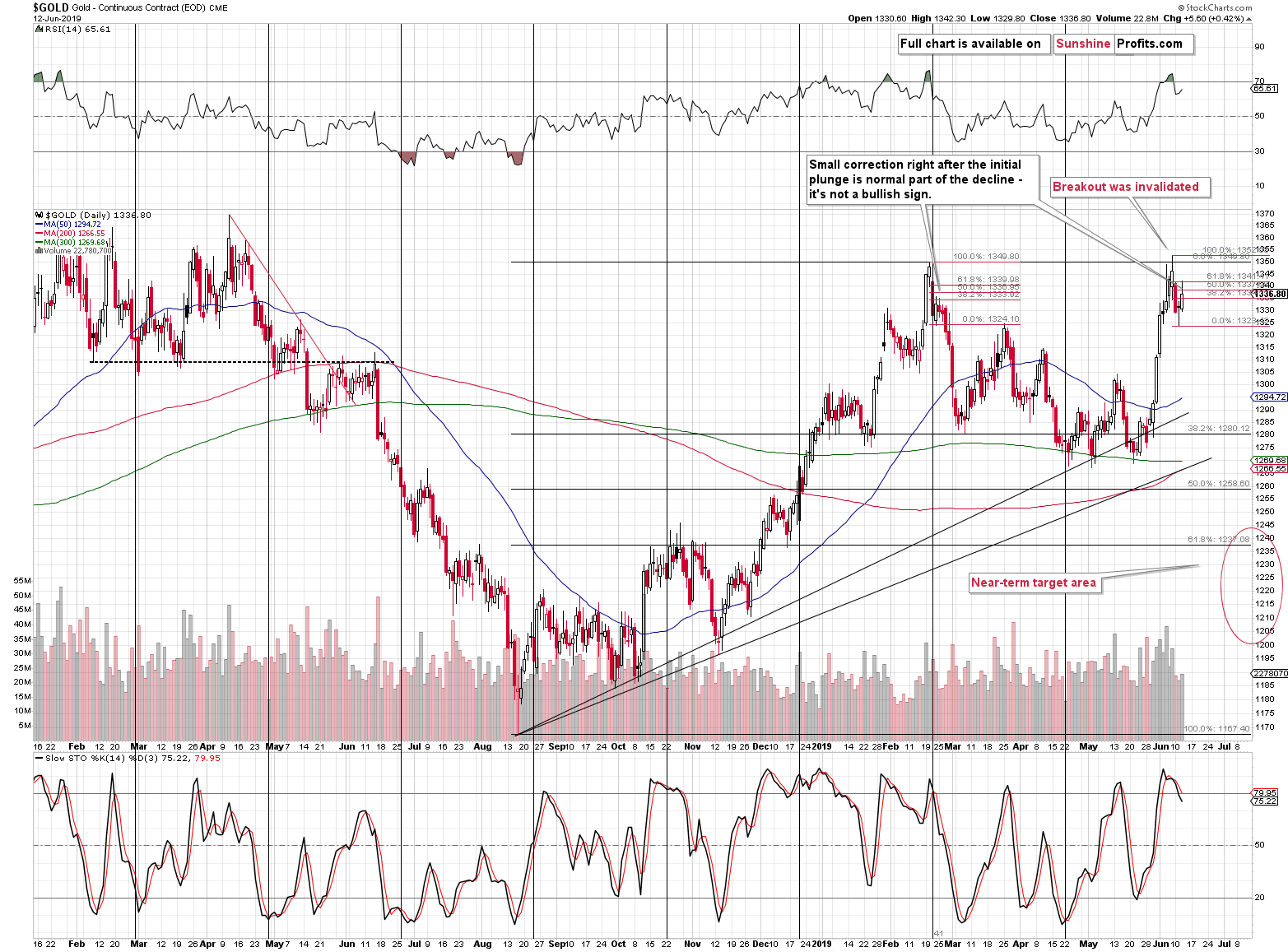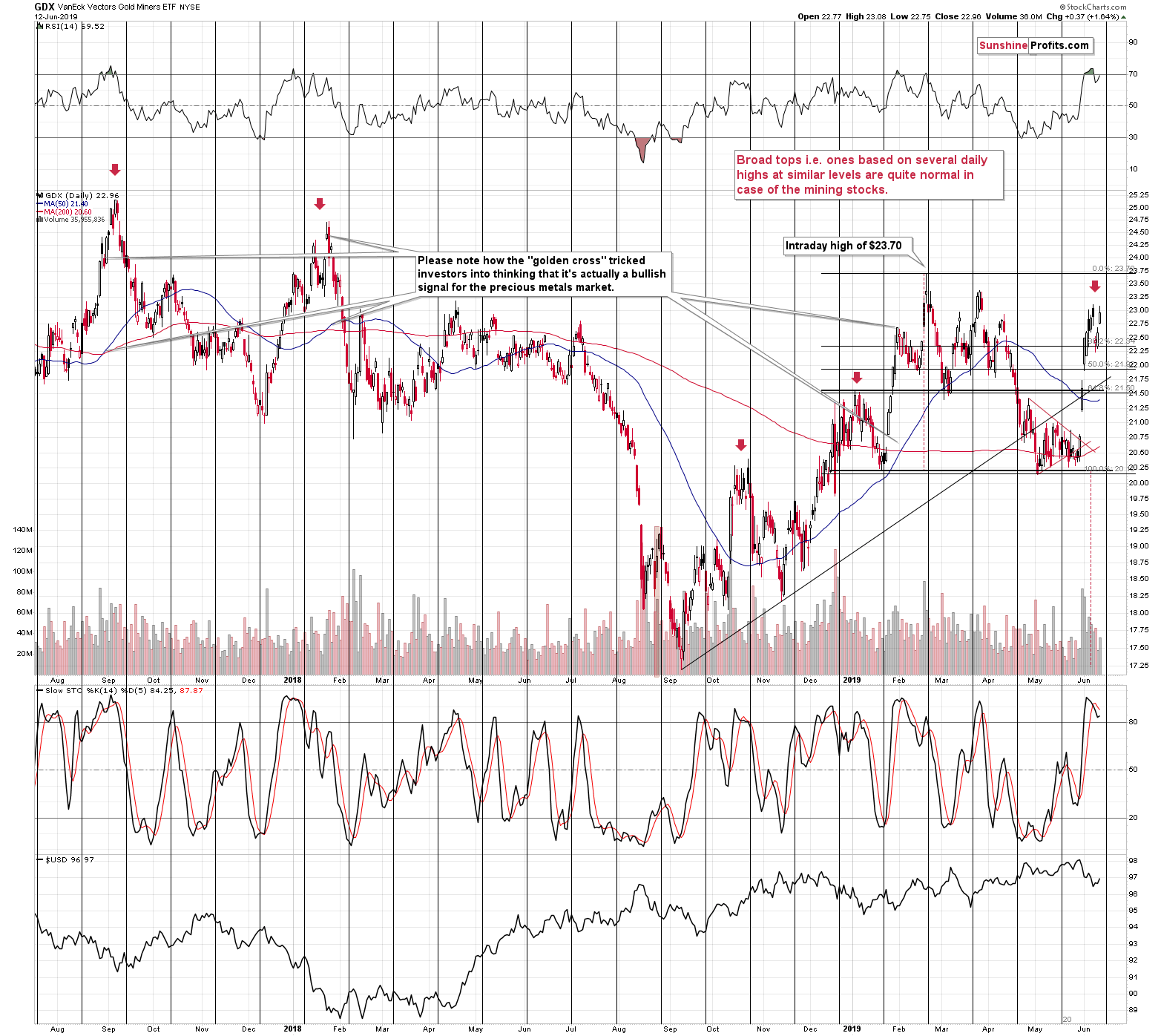Briefly: in our opinion, full (250% of the regular size of the position) speculative short position in gold, silver, and mining stocks are justified from the risk/reward perspective at the moment of publishing this Alert.
In yesterday's analysis, we wrote what kind of corrective upswing in gold could be viewed as normal - and that's exactly what followed. Gold moved a bit higher along with silver, but both gave away a large part of their early gains before the session was over. But not the mining stocks. They held up very well, staying at their recent highs. Quite often strength in the mining stocks heralds higher prices for the PM sector in general - is it the case also this time? In addition to investigating the above, we'll look at what might cause gold to move in a much more volatile manner. The history is a great guide and it has a lot to tell us. Of course, gold can rally and decline without a trigger, but seeing one would definitely open the floodgates. What could make gold really move then?
Let's start with the latter issue. The context is always the king and history repeats itself to a significant degree - at least that's what taking place most of the time. As the current situation is similar to what happened in 2012 and 2013, let's check what took place at or before gold's most volatile downswing.
Gold and the USD Index
It went like this. After several months of back-and-forth trading, the USD Index broke above a medium-term resistance line and started several-week-long rally. That's when gold's decline accelerated. What's important is that this was not what started THE decline. It was the trigger that directly preceded THE decline. It was still quite early with regard to the entire downswing.
Right now, the USD Index is still in the back-and-forth movement pattern. If it wasn't for Trump's very surprising comments, the USD Index would have likely already successfully broken to new highs, with gold correspondingly beeing at new 2019 lows. Instead, gold moved to the previous highs, thus altering the previous similarity a bit. Please note that it was altered, not invalidated.
The upswing that we just saw is clearly similar to the first, and practically only big corrective upswing that we saw during the 2012-2012 decline (not counting the April correction). In 2012, gold moved visibly higher after reaching the 60-week moving average (blue line on the above chart). And that happened when this moving average was already declining.
We saw exactly the same thing recently. Back in 2012, the rally didn't reach the previous high but this time it did. No wonder since so many surprising news (trade tensions with both: Mexico and China, extremely bad jobs report, more dovish remarks from the Fed and mounting market bets on a July rate cut) popped up very close to each other.
However, the USD Index is holding up relatively well, given what cascade of bad news hit it. It declined, but it did not plunge severely. It seems to have bottomed at the rising support line and it moved higher yesterday. The bearish news seems to have been absorbed, and now the trend can resume - the uptrend, that is.
This means that at the next attempt, the USD Index might be able to break above the previous highs and the red resistance line from the previous long-term chart. This could be the trigger that sends gold much lower in a relatively short time.
For now, gold is doing more or less what it's done in late February. It's taking a breather after a volatile decline.
Our yesterday's comments on the above chart remain up-to-date:
In late February, gold corrected almost half of the initial decline before moving much lower. If the history was to repeat itself to the letter, we could see gold move to a bit below $1,340. But, a move to the 61.8% Fibonacci retracement would still not change much - technically, unless gold breaks above it, the correction will be relatively normal.
Of course, we can't rule out a situation in which gold makes a double, or even a triple top as it did in April 2018, but based on the long-term volume analogy, it's likely to slide in the upcoming weeks anyway.
What About Silver and Mining Stocks?
In case of silver and the SLV ETF, our yesterday's comments are even more up-to-date:
Right before Monday's plunge, we warned about the extremely bearish implications of the gravestone doji reversal candlestick. Unlike yesterday's supposedly bullish reversal in gold, Monday's reversal in the SLV ETF took place on huge volume. Yesterday's volume in gold was weak, which suggests that even today's pre-market upswing is likely to be a fake move.
Now, what else can we glean from the above? It can tell us a pause right now is quite normal, and that shorting the precious metals market on Friday most likely meant shorting it right at its top. In late February, we have seen a corrective upswing both in gold and in silver. Both happened after the SLV ETF reached its 20-day moving average. And what happened next? Silver paused for a couple of days, moving a bit higher and then the real plunge happened. This downswing erased the entire previous rally and then some in just a few days.
The other similar situation - from June 2018 - was followed by less sharp, but ultimately bigger decline. Unsurprisingly, there was also a few-day long pause in silver in late June 2018. It was nothing more than a pause within the decline and the same seems likely for the current small upswing.
The size of the current pause is similar to what we saw on both similar occasions. In fact, silver moved a bit higher back then, so we might see a small daily upswing before the decline continues. Only a "daily" one, because both similar pauses took three days to complete. Today is the third day of the pause, so if the history is to repeat itself, the decline is likely to resume shortly.
Ok, but what about the strength in the mining stocks?
Sure, miners look strong at first sight. But let's keep in mind that at times, they can be wrong with their relative strength at the very end of a given move. For instance, miners started 2016 with a breakdown and we all know what followed. Moreover, a topping process marked by several individual daily tops is relatively normal. We marked such cases with red arrows on the above chart - about half of the tops in the mining stocks took this kind of shape. So, is the current action in the mining stocks really bullish? No - it's too early to say so.
Summary
Summing up, it seems that we have just seen a major top in the precious metals market. We had a series of factors that were positive for the PMs sector and negative for the USD Index, but it seems that what could have happened based on them, has already happened. Based on the resistance levels that were reached, and relative performance of gold, silver, and mining stocks, we are very likely to see lower prices this week and in the weeks ahead. Gold and silver moved higher in today's pre-market trading but this is more or less in tune with how gold and silver performed right after gold topped at almost the same price levels in February. Consequently, it seems normal, not bullish.
As always, we'll keep you - our subscribers - informed.
To summarize:
Trading capital (supplementary part of the portfolio; our opinion): Full short position (250% of the full position) in gold, silver, and mining stocks is justified from the risk/reward perspective with the following stop-loss orders and exit profit-take price levels:
- Gold: profit-take exit price: $1,241; stop-loss: $1,382; initial target price for the DGLD ETN: $51.87; stop-loss for the DGLD ETN $38.67
- Silver: profit-take exit price: $13.81; stop-loss: $15.72; initial target price for the DSLV ETN: $39.38; stop-loss for the DSLV ETN $26.97
- Mining stocks (price levels for the GDX ETF): profit-take exit price: $17.61; stop-loss: $24.17; initial target price for the DUST ETF: $34.28; stop-loss for the DUST ETF $13.37
In case one wants to bet on junior mining stocks' prices (we do not suggest doing so - we think senior mining stocks are more predictable in the case of short-term trades - if one wants to do it anyway, we provide the details), here are the stop-loss details and target prices:
- GDXJ ETF: profit-take exit price: $24.71; stop-loss: $35.67
- JDST ETF: profit-take exit price: $78.21 stop-loss: $30.97
Long-term capital (core part of the portfolio; our opinion): No positions (in other words: cash)
Insurance capital (core part of the portfolio; our opinion): Full position
Whether you already subscribed or not, we encourage you to find out how to make the most of our alerts and read our replies to the most common alert-and-gold-trading-related-questions.
Please note that the in the trading section we describe the situation for the day that the alert is posted. In other words, it we are writing about a speculative position, it means that it is up-to-date on the day it was posted. We are also featuring the initial target prices, so that you can decide whether keeping a position on a given day is something that is in tune with your approach (some moves are too small for medium-term traders and some might appear too big for day-traders).
Plus, you might want to read why our stop-loss orders are usually relatively far from the current price.
Please note that a full position doesn't mean using all of the capital for a given trade. You will find details on our thoughts on gold portfolio structuring in the Key Insights section on our website.
As a reminder - "initial target price" means exactly that - an "initial" one, it's not a price level at which we suggest closing positions. If this becomes the case (like it did in the previous trade) we will refer to these levels as levels of exit orders (exactly as we've done previously). Stop-loss levels, however, are naturally not "initial", but something that, in our opinion, might be entered as an order.
Since it is impossible to synchronize target prices and stop-loss levels for all the ETFs and ETNs with the main markets that we provide these levels for (gold, silver and mining stocks - the GDX ETF), the stop-loss levels and target prices for other ETNs and ETF (among other: UGLD, DGLD, USLV, DSLV, NUGT, DUST, JNUG, JDST) are provided as supplementary, and not as "final". This means that if a stop-loss or a target level is reached for any of the "additional instruments" (DGLD for instance), but not for the "main instrument" (gold in this case), we will view positions in both gold and DGLD as still open and the stop-loss for DGLD would have to be moved lower. On the other hand, if gold moves to a stop-loss level but DGLD doesn't, then we will view both positions (in gold and DGLD) as closed. In other words, since it's not possible to be 100% certain that each related instrument moves to a given level when the underlying instrument does, we can't provide levels that would be binding. The levels that we do provide are our best estimate of the levels that will correspond to the levels in the underlying assets, but it will be the underlying assets that one will need to focus on regarding the signs pointing to closing a given position or keeping it open. We might adjust the levels in the "additional instruments" without adjusting the levels in the "main instruments", which will simply mean that we have improved our estimation of these levels, not that we changed our outlook on the markets. We are already working on a tool that would update these levels on a daily basis for the most popular ETFs, ETNs and individual mining stocks.
Our preferred ways to invest in and to trade gold along with the reasoning can be found in the how to buy gold section. Additionally, our preferred ETFs and ETNs can be found in our Gold & Silver ETF Ranking.
As a reminder, Gold & Silver Trading Alerts are posted before or on each trading day (we usually post them before the opening bell, but we don't promise doing that each day). If there's anything urgent, we will send you an additional small alert before posting the main one.
=====
Latest Free Trading Alerts:
U.S. consumer inflation has moderated recently. Trade wars go on. What the Fed will do now? Let's not forget the recent ECB monetary policy meeting. It carries implications for both EUR/USD and gold. Just what are they?
Soft Inflation Data and Concerned Draghi. How Will Gold Like It?
Wednesday's trading session was slightly bearish, as investors took more short-term profits off the table following the recent advances. However, the daily trading range was very narrow. The S&P 500 index reached the new local high on Tuesday and then it came back below the 2,900 mark. So was it a downward reversal or just correction before another leg up?
=====
Thank you.
Sincerely,
Przemyslaw Radomski, CFA
Editor-in-chief, Gold & Silver Fund Manager








